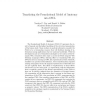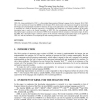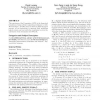WS
2008
ACM
14 years 3 months ago
2008
ACM
The Foundational Model of Anatomy (FMA) [7] represents the result of manual and disciplined modeling of the structural organization of the human body. Many workers in medical info...
FUIN
2008
14 years 3 months ago
2008
Many popular ontology languages are based on (subsets of) first-order predicate logic, with classes represented by unary predicates and properties by binary predicates. Specificall...
IADIS
2004
14 years 4 months ago
2004
OWL DL, being established by W3C, is a Knowledge Representation Markup Language for the Semantic Web. OWL DL is a new synthesis of research on KRML for the Semantic Web, which nee...
OWLED
2007
14 years 5 months ago
2007
Existing approaches for querying OWL DL do either only operate on syntactic constructs without taking into account the semantics of OWL or do only have a restricted access to the T...
OWLED
2008
14 years 5 months ago
2008
The Ontology for Biomedical Investigations (OBI), written in OWL DL, is being developed by a large consortium seeking to provide a crossdomain, shared framework for representing in...
SEMWEB
2009
Springer
14 years 8 months ago
2009
Springer
Scalable query answering over Description Logic (DL) based ontologies plays an important role for the success of the Semantic Web. Towards tackling the scalability problem, we prop...
SEMWEB
2004
Springer
14 years 8 months ago
2004
Springer
OWL DL corresponds to a Description Logic (DL) that is a fragment of classical first-order predicate logic (FOL). Therefore, the standard methods of automated reasoning for full F...
WWW
2005
ACM
15 years 4 months ago
2005
ACM
The correctness of the Z semantics of OWL is the theoretical foundation of using software engineering techniques to verify Web ontologies. As OWL and Z are based on different logi...



